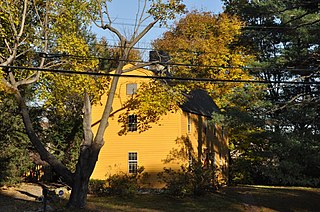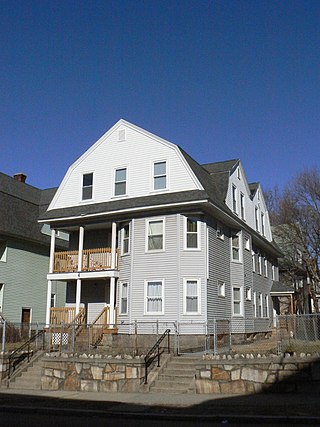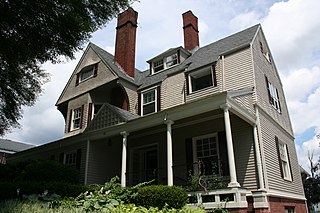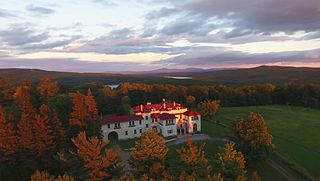
Putnam Cottage was also known as Knapp Tavern during the American Revolution. It is located at 243 East Putnam Avenue, on the former route of the Boston Post Road, in Greenwich, Connecticut.

Barlin Acres was an historic house located on what is now East Temple Street in Boylston, Massachusetts. Built in 1734 and eventually transformed into a summer estate house, it was home to a founder of Boylston, and a good example of colonial and Federal period architecture. The house was listed on the National Register of Historic Places on November 26, 1982. It was subsequently demolished to make way for the clubhouse of the Cyprian Keyes Golf Club, which now stands on its site. The clubhouse contains architectural elements recovered from the house, including some flooring and the 19th century Music Room.

The Willard-Fisk House is a historic farm property at 126 Whitney Street in Holden, Massachusetts. The farmhouse, built about 1772, is one of the oldest houses in Holden, and one of its oldest brick houses. The property also includes a 19th-century barn and several 20th-century farm outbuildings. The property was listed on the National Register of Historic Places in 1996, where it is listed at 121 Whitney Street.

The Golden Ball Tavern is a historic tavern, now a museum, located in Weston, Massachusetts. Built in 1768, it is one of the town's finest examples of Late Georgian architecture. It also played a pivotal role in local activities during the American Revolution, due to its Loyalist tavern keeper. The tavern was listed on the National Register of Historic Places in 1972, and was included in Weston's Boston Post Road Historic District in 1983.

The Capt. William Green House is a historic colonial house at 391 Vernon Street in Wakefield, Massachusetts. It is one of Wakefield's oldest surviving buildings. The house was listed on the National Register of Historic Places as part of two separate listings. In 1989 it was listed under the name "Capt. William Green House", and in 1990 it was listed under the name "Green House".

The Amos Flagg House is a historic colonial-era house at 246 Burncoat Street in Worcester, Massachusetts. Built about 1748, it is one of the city's few surviving 18th-century buildings. The house was listed on the National Register of Historic Places in 1980.

The Lars Petterson-James Reidy Three-Decker is a historic triple decker house in Worcester, Massachusetts. The house was built c. 1910 by Lars Petterson, a local builder who developed several other Worcester properties. When the house was listed on the National Register of Historic Places in 1990, its Colonial Revival detailing was cited, including square posts supporting the porches and a modillioned cornice. Some of these details have been lost or covered over by subsequent exterior alterations.

The Chadwick-Brittan House is a historic house at 309 Lincoln Street in Worcester, Massachusetts. It is estimated to have been built c. 1797, and is one of the few surviving Federal-style houses in the city. It was listed on the National Register of Historic Places in 1980.

The Joseph Davis House is a historic house at 41 Elm Street in Worcester, Massachusetts. The Shingle style house was built in 1884 to a design by the Boston architectural firm of Peabody & Stearns, and is one of the most elaborate of that style in the city. It was built for Joseph Davis, the son of prominent Worcester lawyer Isaac Davis, and was home for many years to William Rice, president of the Washburn and Moen Company The house was listed on the National Register of Historic Places in 1980. It now houses professional offices.

Fairlawn is a historic mansion at 189 May Street in Worcester, Massachusetts. It is now part of the main building of the Fairlawn Rehabilitation Hospital. The mansion were the property of James Norcross, a nationally prominent builder whose Norcross Brothers firm was engaged in construction projects involving famous architects, including H. H. Richardson and McKim, Mead & White. The Norcross brothers were also locally prominent, building a number of Worcester landmarks and operating a factory in the city which produced architectural parts.

The Frank McPartland Three-Decker is a historic triple-decker house in Worcester, Massachusetts. Built about 1912, it is a well-preserved instance of a typical modestly styled Colonial Revival three decker, although some architectural details have been lost to subsequent exterior changes. The house was listed on the National Register of Historic Places in 1990.

The Bridget Shea Three-Decker is a historic triple decker house in Worcester, Massachusetts. Built c. 1888, the house was described as a well-preserved Queen Anne structure when it was listed on the National Register of Historic Places in 1990. It has since lost many of its period details.

The Tousley-Church House is located on North Main Street in Albion, New York, United States. It is a brick house in the Greek Revival architectural style built in two different stages in the mid-19th century.

The Benjamin Thayer House is a historic house at 200 Farm Street in Blackstone, Massachusetts. Built around 1790, it is the best-preserved property associated with the Thayer family, who were prominent landowners and one of the first Pilgrim families. Benjamin Thayer and his descendants lived and farmed here until about 1920, when the property, much reduced in size, was sold out of the family. The house and its surrounding 9 acres (3.6 ha) of surviving farmland was listed on the National Register of Historic Places in 2009.

The Brown-Davis-Frost Farm, now called Lantern House Farm, is a historic farm property at 17 Whitney Street in Jefferson, a village of Holden, Massachusetts. It has a history dating to the 18th century, and includes one Holden's oldest brick houses. The property was listed on the National Register of Historic Places in 1995.

Aldworth Manor, also known as the Arthur E. Childs House, is a historic summer estate house in rural Harrisville, New Hampshire. The house is located at the top of a hill at the end of Aldworth Road, formerly the estate's access drive, and was one of the premiere estate houses of the early 20th century in the town. The house was originally built c.1850 in Worcester, Massachusetts. It was inherited by Arthur E. Childs, a Worcester native from a wealthy family, in the early 20th century.

The Gen. John Stark House is a historic house museum at 2000 Elm Street in Manchester, New Hampshire. The house, a single-story Cape style farmhouse, was built in 1736 by Archibald Stark. Stark's son John, a hero of the American Revolutionary War, lived in this house from 1736 to 1765; it is where he brought his new bride Molly, and where two of their children were born. It was listed on the National Register of Historic Places in 1973. It is now operated as a museum by the local chapter of the Daughters of the American Revolution.

John Murray was the elected Representative to the Great and General Court of the Province of Massachusetts Bay from 1751 to 1774 for Rutland, Rutland's Northwest District and later for Hubbardston and Oakham. He was principal in the transactional and legislative founding of Barre, Oakham, Athol and Hubbardston. Often honored by the colonial government he was driven from his home in August of 1774 and forced to flee to Boston.

The John Strong Mansion Museum or John Strong House is a historic house museum on Vermont Route 17W in Addison, Vermont. It was built in 1795-96 by John Strong, a Vermont politician and veteran of the American Revolutionary War. It is one of Vermont's grandest examples of late 19th-century Federal architecture. It is now operated as a museum by the Daughters of the American Revolution, open between Memorial Day and Labor Day. It is surrounded by D.A.R. State Park. The house was listed on the National Register of Historic Places in 1980.

The Fobes-O'Donnell House is a historic house museum at 1221 Old Turnpike Road in Oakham, Massachusetts. Probably built in the second half of the 18th century, it served as a tavern on what was then a major through road, and housed the town's first post office. It is now operated as a museum by the local historical society. The house was listed on the National Register of Historic Places in 2018.























